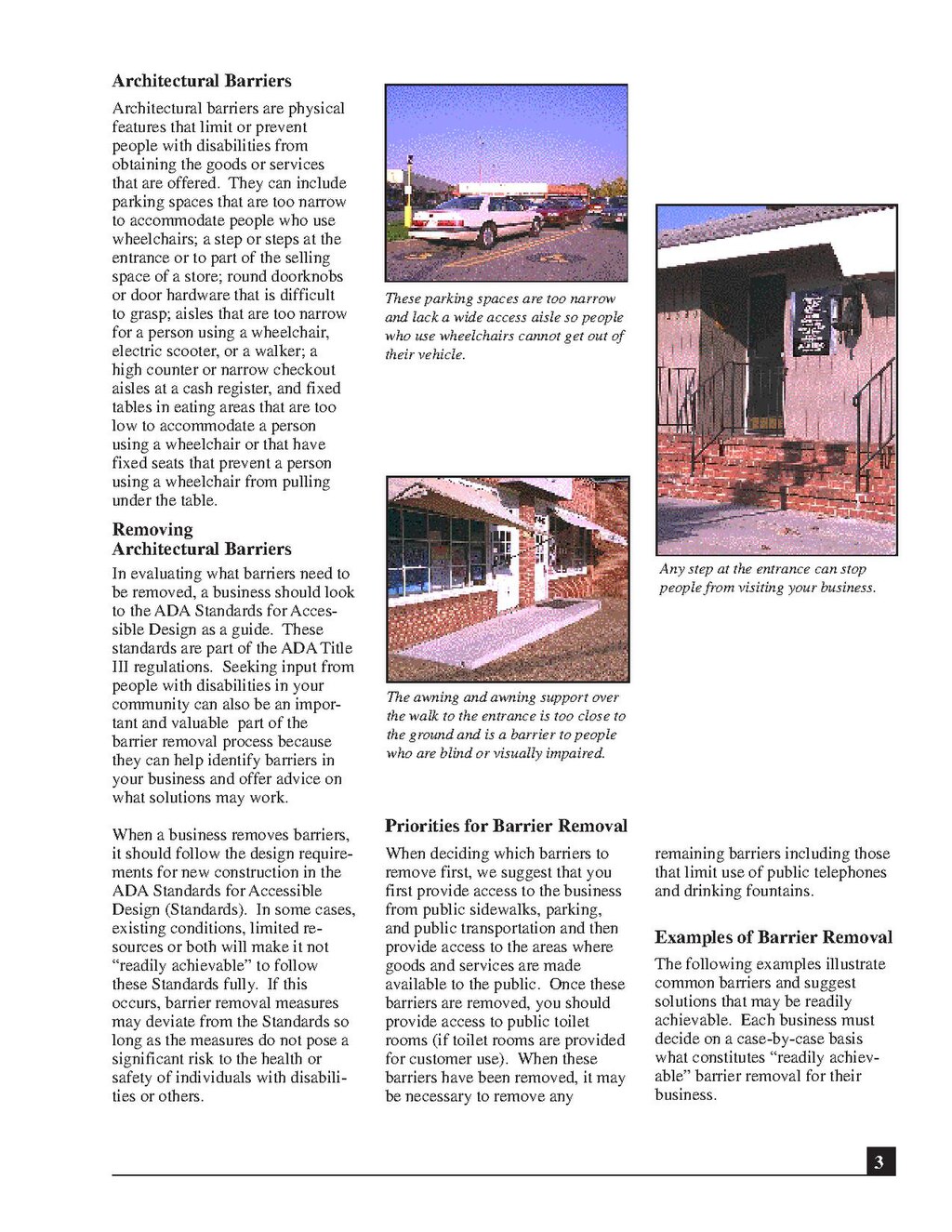Architectural Barriers
Architectural barriers are physical features that limit or prevent people with disabilities from obtaining the goods or services that are offered. They can include parking spaces that are too narrow to accommodate people who use wheelchairs; a step or steps at the entrance or to part of the selling space of a store; round doorknobs or door hardware that is difficult to grasp; aisles that are too narrow for a person using a wheelchair, electric scooter, or a walker; a high counter or narrow checkout aisles at a cash register, and fixed tables in eating areas that are too low to accommodate a person using a wheelchair or that have fixed seats that prevent a person using a wheelchair from pulling under the table.
An image should appear at this position in the text. To use the entire page scan as a placeholder, edit this page and replace "{{missing image}}" with "{{raw image|ADA Guide for Small Businesses (1999).pdf/7}}". Otherwise, if you are able to provide the image then please do so. For guidance, see Wikisource:Image guidelines and Help:Adding images. |
These parking spaces are too narrow and lack a wide access aisle so people who use wheelchairs cannot get out of their vehicle.
Removing
Architectural Barriers
In evaluating what barriers need to be removed, a business should look to the ADA Standards for Accessible Design as a guide. These standards are part of the ADA Title III regulations. Seeking input from people with disabilities in your community can also be an important and valuable part of the barrier removal process because they can help identify barriers in your business and offer advice on what solutions may work.
When a business removes barriers, it should follow the design requirements for new construction in the ADA Standards for Accessible Design (Standards). In some cases, existing conditions, limited resources or both will make it not “readily achievable” to follow these Standards fully. If this occurs, barrier removal measures may deviate from the Standards so long as the measures do not pose a significant risk to the health or safety of individuals with disabilities or others.
An image should appear at this position in the text. To use the entire page scan as a placeholder, edit this page and replace "{{missing image}}" with "{{raw image|ADA Guide for Small Businesses (1999).pdf/7}}". Otherwise, if you are able to provide the image then please do so. For guidance, see Wikisource:Image guidelines and Help:Adding images. |
Any step at the entrance can stop people from visiting your business.
An image should appear at this position in the text. To use the entire page scan as a placeholder, edit this page and replace "{{missing image}}" with "{{raw image|ADA Guide for Small Businesses (1999).pdf/7}}". Otherwise, if you are able to provide the image then please do so. For guidance, see Wikisource:Image guidelines and Help:Adding images. |
The awning and awning support over the walk to the entrance is too close to the ground and is a barrier to people who are blind or visually impaired.
Priorities for Barrier Removal
When deciding which barriers to remove first, we suggest that you first provide access to the business from public sidewalks, parking, and public transportation and then provide access to the areas where goods and services are made available to the public. Once these barriers are removed, you should provide access to public toilet rooms (if toilet rooms are provided for customer use). When these barriers have been removed, it may be necessary to remove any remaining barriers including those that limit use of public telephones and drinking fountains.
Examples of Barrier Removal
The following examples illustrate common barriers and suggest solutions that may be readily achievable. Each business must decide on a case-by-case basis what constitutes “readily achievable” barrier removal for their business.
